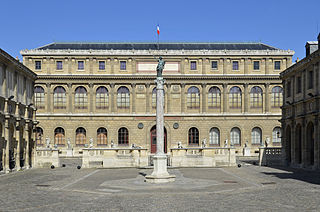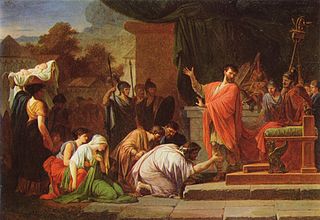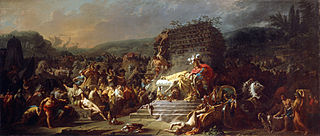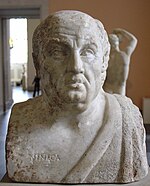
Jacques-Louis David was a French painter in the Neoclassical style, considered to be the preeminent painter of the era. In the 1780s, his cerebral brand of history painting marked a change in taste away from Rococo frivolity toward classical austerity and severity and heightened feeling, harmonizing with the moral climate of the final years of the Ancien Régime.

François Boucher was a French painter, draughtsman and etcher, who worked in the Rococo style. Boucher is known for his idyllic and voluptuous paintings on classical themes, decorative allegories, and pastoral scenes. He was perhaps the most celebrated painter and decorative artist of the 18th century.

The Prix de Rome or Grand Prix de Rome was a French scholarship for arts students, initially for painters and sculptors, that was established in 1663 during the reign of Louis XIV of France. Winners were awarded a bursary that allowed them to stay in Rome for three to five years at the expense of the state. The prize was extended to architecture in 1720, music in 1803 and engraving in 1804. The prestigious award was abolished in 1968 by André Malraux, then Minister of Culture, following the May 68 riots that called for cultural change.

The Beaux-Arts de Paris is a French grande école whose primary mission is to provide high-level arts education and training. This is classical and historical School of Fine Arts in France. The art school, which is part of the Paris Sciences et Lettres University, is located on two sites: Saint-Germain-des-Prés in Paris, and Saint-Ouen.

The Prix Théophraste-Renaudot or Prix Renaudot is a French literary award.

Michel Déon was a French novelist and literary columnist. He published over 50 works and was the recipient of numerous awards, including the Prix Interallié for his 1970 novel, Les Poneys sauvages. Déon's 1973 novel Un taxi mauve received the Grand Prix du roman de l'Académie française. His novels have been translated into numerous languages.
Pierre Max Rosenberg is a French art historian, curator, and professor. Rosenberg is the honorary president a director of the Musée du Louvre in Paris, and since 1995, he has held the 23rd seat of the Académie Française. He was Slade Professor of Fine Art at the University of Cambridge in 1987.

The Death of Marat is a 1793 painting by Jacques-Louis David depicting the artist's friend and murdered French revolutionary leader, Jean-Paul Marat. One of the most famous images from the era of the French Revolution, David painted it when he was the leading French Neoclassical painter, a Montagnard, and a member of the revolutionary Committee of General Security. Created in the months after Marat's death, the painting shows Marat lying dead in his bath after his murder by Charlotte Corday on 13 July 1793. Art historian T. J. Clark called David's painting the first modernist work for "the way it took the stuff of politics as its material, and did not transmute it".
Louis Pauwels was a French journalist and writer.

Jean-François Pierre Peyron, full name of Pierre Peyron, was a French Neoclassical painter.

Michel Martin Drolling was a neoclassic French painter, painter of history and portraitist.

The Death of Socrates is an oil on canvas painted by French painter Jacques-Louis David in 1787. The painting was part of the neoclassical style, popular in the 1780s, that depicted subjects from the Classical age, in this case the story of the execution of Socrates as told by Plato in his Phaedo. In this story, Socrates has been convicted of corrupting the youth of Athens and introducing strange gods, and has been sentenced to die by drinking poison hemlock. Socrates uses his death as a final lesson for his pupils rather than fleeing when the opportunity arises, and faces it calmly. The Phaedo depicts the death of Socrates and is also Plato's fourth and last dialogue to detail the philosopher's final days, which is also detailed in Euthyphro, Apology, and Crito.

Minerva Fighting Mars is an oil-on-canvas painting created in 1771 by Jacques-Louis David and now in the Louvre.

Diana and Apollo Killing Niobe's Children is a 1772 oil-on-canvas painting by the french artist Jacques-Louis David, now in the Dallas Museum of Art. He produced it to compete for the Prix de Rome. In the Rococo style which marked his early period, it was emblematic of the conflict between David and the Académie royale de peinture et de sculpture jury, which refused him the prize following a pre-arranged vote.

The Funeral Games of Patroclus is a 1778 oil-on-canvas painting by the French artist Jacques-Louis David. It shows the funeral games for Patroclus during Trojan War, with his body and Achilles at the foot of the pyre and Hector resting on his chariot on the right. It was first exhibited at the Palazzo Mancini in Rome in September 1778, where it was a critical success. It was then lost until 1972, when it was acquired by the National Gallery of Ireland, its present home.

The royal monastery of Saint-Bernard, better known as the Couvent des Feuillants or Les Feuillants Convent, was a Feuillant nunnery or convent in Paris, behind what is now numbers 229—235 rue Saint-Honoré, near its corner with rue de Castiglione. It was founded in 1587 by Henry III of France. Its church was completed in 1608 and dedicated to Saint Bernard of Clairvaux.

Portrait of Alphonse Leroy is a 1783 portrait of doctor and man-midwife Alphonse Leroy by Jacques-Louis David, now in the Musée Fabre in Montpellier, which bought it in 1829.

The Shepherds is a c. 1717 painting by Antoine Watteau, now in the Schloss Charlottenburg in Berlin. It is the most finished version of a composition later reused by the same artist in Pastoral Pleasure.

The Chord, alternatively known as The Serenader and Mezzetino, is an oil on panel painting in the Musée Condé, Chantilly, by the French Rococo painter Antoine Watteau, variously dated c. 1714–1717. Throughout the 18th and 19th centuries, The Chord passed through numerous private collections, until it came into possession of Henri d'Orléans, Duke of Aumale, son of King Louis Philippe I; as part of the Duke of Aumale's collection at the Château de Chantilly, The Chord was bequeathed to the Institut de France in 1884.

Les Femmes Gauloises is a painting by Auguste-Barthélemy Glaize. It is a very large oil on canvas work, with a height of 424cm and a width of 651cm. It was created in 1851, exhibited at the 1852 Salon and purchased by the French state in 1853.



















